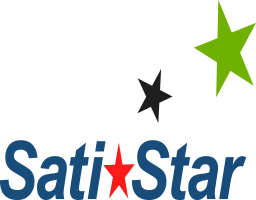Distance Education (e-Learning)
Overview
Distance Education is characterized by a deliberately integrated multiple-media ‘print + broadcasting’ approach, with learning materials specifically designed for study at a distance. It is often is based on two-way communications media such as the Internet or video-conferencing that enable interaction between the teacher and the remote student as well as among students, either individually or as groups, but at a distance. Students can study in their own time, at the place of their choice (home, work or learning centre), with or without face-to-face contact with a teacher.
SatiStar’s approach to distance education combines technical architecture with the value-added activities and skills needed to implement a distributed education environment. Since a distance education program is so dependent on technology, our approach is focused towards answering the key question, “Under what circumstances and for what instructional purposes is a technology best used?”
SatiStar offers a standardized methodology that results in a customized solution that is sustainable, culturally sensitive and combines the technical with the nuances of educational best practices and methods. This unique marriage of the technical and social aspects of our solution for educational processes considers:
- Access: how accessible is a particular technology for the targeted learners?
- Costs: what is the cost structure of each technology?
- Teaching and learning: what kinds of learning are needed? What are the best technologies for supporting desired teaching and learning?
- Interactivity and user-friendliness: the kinds of interactions various technologies enable
- The unique educational characteristics of each technology
- How well these match the learning and teaching requirements?
- Organizational issues: Organizational requirements, and potential changes in organization
- Novelty: how new is the technology?
- Speed: how quickly can courses be mounted with various technologies?
- The kinds of learning needing to be developed
- Instructional strategies to be employed to enable the needed learning
Scope And Deliverables
SatiStar’s comprehensive approach for Distance Education is designed to reduce the overall cycle time for a typical implementation, through a highly structured methodology designed to deliver a fully customized solution for each client.
We begin with assessing the specific goals and objective of a distance education program in relation to the technical requirements and constraints that facilitate selecting an appropriate model:
- Assess, Diagnose & Recommend
- Determine the specific goals and objectives of the Distance Education program
- Internal and external funding policies and practices
- Develop profound understanding of current methods and capabilities
- Provide measurable Distance Education targets
- Provide recommendation and roadmap (including timelines and costs) on how to implement the Distance Education Program
- System design and architecture
- On-campus and distance courses delivered online
- Mixed mode or hybrid
- Blended combination of face-to-face and online teaching
- Infrastructure architecture and bandwidth
- IT Service Management and technical support
- Facility design optimization
- Workflow / Adjacencies
- Resource optimization
- Teaming / Hoteling
- Audio / Video
- Social spaces
- Space standards
- Efficient planning
- Ergonomics
- Universal access
- Security
- LEED® principles
- Image
- Branding
- Culture and Values
- Aesthetics
- Costs and budgeting
- Cost complexities of the technical options
- Business plan
- Critical success factors for programme design and delivery;
- The unique educational characteristics of each technology, and how well these match the learning and teaching requirements and capabilities
- Management control systems for programme administration
- Registration
- Administration
- Operations
- IT services management, support and policies
- Faculty development and technical support
- The kinds of learning to be developed
- Instructional strategies to be employed to enable the learning needed
- Faculty comfort levels with technical options
- School culture
- Student access
- Requirements and constraints
- Synchronous or asynchronous
- Materials distribution
- Curriculum and course scheduling
- Student assessment.
- Administering tests and examinations
- Evaluation and feedback
- Security
- Appropriate authentication and access control at the user interface
- Use of secure transmission methodologies
- Control of unauthorized use
- Consistent control of access to materials and resources across all University systems
- Implementation
- Process and systems design (Specification Document)
- Vendor Selection
- Service-Level Management (SLM)
- SLAs, OLAs, Underpinning contracts with vendors
- Facilitate / guide implementation (Project Management)
- Supporting documentation
- Key Performance Indicators (KPIs) & Reporting
- Service transition
- Change Management
- Availability and Capacity Management
- Asset & Configuration Management
- Knowledge Management
- Release Management
- Testing
- Failure testing
- System testing
- User testing
- Deployment, decommission & transfer
- Service operations
- Service Request Management
- Event Management
- Incident Management
- Problem Management
- Access Management
- Security management
What We Will Do
- Conduct an assessment
- Project Management
- Provide model of the target state
- Gap Assessment to target state
- Provide models and templates for rapid deployment and implementation
- Failure Modes and Effects Analysis (FMEA) – Risk identification and prioritization
- Management and instructor training
- Overall program and methods
- Coaching on content creation and management
- System configuration specifications
- Guide implementation
- Create document structure
- Create policy manual
- Process Reference documents
- Audit requirements
- Security requirements
- Technical specifications and support models
- Procedures and work instructions
What We Need You To Do
- Provide us with the contact information of your key personnel.
- Authorize each of these personnel to provide SatiStar with information that we will use for our work.
- Ensure availability of these personnel for us to be able to obtain the required information in a timely fashion.
- Provide access to relevant personnel (those who actually do the job) to enable SatiStar’s personnel to map out the key business processes, instructional and technical requirements.
- Provide a list of required school documents and records.
WHAT PEOPLE ARE SAYING
SatiStar's Experience Makes The Difference!
